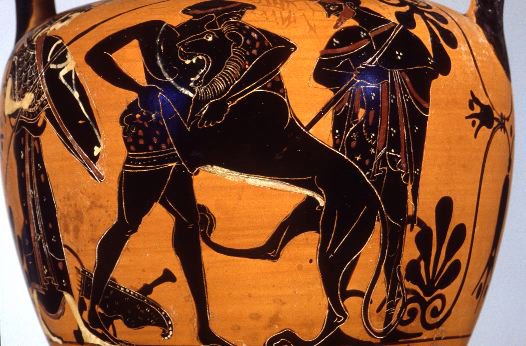
HOME || NEXT LABOUR
King Eurystheus decided Hercules' first task would be to bring him the skin of an invulnerable lion which terrorized the hills around Nemea.
Setting out on such a seemingly impossible task, Hercules came to a town called Cleonae, where he stayed at the house of a poor workman-for-hire, Molorchus. When his host offered to sacrifice an animal to pray for a safe lion hunt, Hercules asked him to wait 30 days. If the hero returned with the lion's skin, they would sacrifice to Zeus, king of the gods. If Hercules died trying to kill the lion, Molorchus agreed to sacrifice instead to Hercules, as a hero.

Hercules wrestling the Nemean lion Mississippi 1977.3.62, Attic black figure neck amphora, ca. 510-500 B.C. Photograph by Maria Daniels, courtesy of the University Museums, University of Mississippi
|
|
When Hercules got to Nemea and began tracking the terrible lion, he soon discovered his arrows were useless against the beast. Hercules picked up his club and went after the lion. Following it to a cave which had two entrances, Hercules blocked one of the doorways, then approached the fierce lion through the other. Grabbing the lion in his mighty arms, and ignoring its powerful claws, he held it tightly until he'd choked it to death. Hercules returned to Cleonae, carrying the dead lion, and found Molorchus on the 30th day after he'd left for the hunt. Instead of sacrificing to Hercules as a dead man, Molorchus and Hercules were able to sacrifice together, to Zeus. When Hercules made it back to Mycenae, Eurystheus was amazed that the hero had managed such an impossible task. The king became afraid of Hercules, and forbade him from entering through the gates of the city. Furthermore, Eurystheus had a large bronze jar made and buried partway in the earth, where he could hide from Hercules if need be. After that, Eurystheus sent his commands to Hercules through a herald, refusing to see the powerful hero face to face. |
Hercules wearing the lion skin Boston 99.538, Attic bilingual amphora, ca. 525-500 B.C. Photograph courtesy,Museum of Fine Arts, Boston. H. L. Pierce Fund